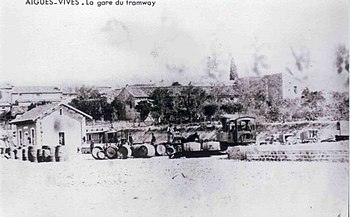Chemin de Fer d'Aigues-Vives
| Chemin de Fer d'Aigues-Vives-Bourg a Aigues-Vives PLM | |||||||||||||
|---|---|---|---|---|---|---|---|---|---|---|---|---|---|
|
Weidknecht locomotive at Aigues-Vives station
Former route on a modern map | |||||||||||||
|
PLM station on a historical map (north is below)
| |||||||||||||
| Route length: | 1.697 km | ||||||||||||
| Gauge : | 600 mm ( narrow gauge ) | ||||||||||||
|
|||||||||||||
The Chemin de Fer d'Aigues-Vives ( French Chemin de Fer d'Aigues-Vives-Bourg a Aigues-Vives PLM , colloquially Tramway or Lignette ) was a scarce operated from 1892-1901 by the Compagnie Nationale de Chemins de Fer à Voie Étroite 2km long light railway in Aigues-Vives in the department of Gard in the region Occitania in France .
history
planning
The light railway with a gauge of 600 mm connected the Aigues-Vives station on the Nîmes - Lunel line of the Compagnie des chemins de fer de Paris à Lyon et à la Méditerranée (PLM) with the local fruit processing companies. The companies produced, among other things, wine, jams and fruit syrup as well as wooden barrels for transporting these fruit-based products.
The fact that Émile Jamais , a member of the National Assembly , who was born in Aigues-Vives, was a member of the Railway Commission compiled for the concession application in June 1886 explains why the latter is comfortable with the laws governing the construction of narrow-gauge railways and the necessary applications knew. The concession for the local railway was awarded in 1891 to the Compagnie Nationale des Chemins de Fer a Voie Etroite (nationwide state company for narrow-gauge railways) and three Parisian investors, who immediately began to carry out the construction work.
Track construction
The final route was set in 1891 and the transportation tariffs approved. The railway was completed in early 1892 and officially put into operation on June 18, 1892. The 1697 m long single-track line ran from Aigues Vives to the PLM Aigues Vives station on a 3.20 m wide route.
business
The original concessionaire was the Compagnie Nationale de Chemins de Fer a Voie Etroite with effect from 1891. This was a short-lived company that worked from a Paris luxury hotel, probably just speculators. The Conseil Municipal promoted the project. The Société Cévenole du Chemin de Fer d'Aigues-Vives-Bourg a Aigues-Vives PLM has operated the line since 1897.
According to the timetable, four trains with one passenger car per day were used for mixed passenger and freight traffic in each direction. The local traders had undertaken to transport all goods they bought or sold by rail. In the last years of the 19th century more than 40 houses, some of them very important, were active in the wholesale or barrique wine trade. At this time, the economic prosperity of Aigues-Vives reached its first peak. Later, the wine was only bottled in the consumer countries, whereby the direct transport from the winery was initially made much easier with wine barrel wagons and later with tank wagons . As a result, the cooper and finally the wine wholesalers gradually disappeared, so that the transport volume fell.
Shutdown
On February 6, 1901, operations were stopped due to financial difficulties. On March 28, 1901, the company was dissolved due to the accumulated deficit. The rail vehicles were sold. The disused route was dismantled, only the small bridges were initially preserved, and parts of the route were used as a dirt road that runs almost parallel to the Rue de la Gare , which leads from the village to the train station. The site of the former narrow-gauge station was later used for driving cattle and, from 1931, as a bullring and a fairground.
Rail vehicles
- No. 1 and No. 2: Two three-axle B1 '2nt steam locomotives from Weidknecht (manufacturer No. 568 and 569, delivered in 1892).
- A two-axle B 2nt steam locomotive from Orenstein & Koppel (same design as the locomotive of the sand pits from Nemours )
- Open and covered goods wagons from the Decauville company
Individual evidence
- ↑ Cadastral maps on www.geoportail.gouv.fr
- ^ FACS: Compagnie Nationale de Chemins de Fer à Voie Étroite.
- ↑ Henri Domengie: Les petits trains de jadis.
- ^ Nicolas Lasserre: Aigues Vives et ses hommes célèbres. Lacour éditeur, 2001.
- ↑ Jean Claude Gaussent (ed.): Grandes figures de Vaunage et Petite Camargue (Gaston Doumergue, Emile Jamais and Fernand Granon). Mémoires d'Oc Editions. 2008.
- ^ Pont de la Cooperative.
Coordinates: 43 ° 43 ′ 40.5 " N , 4 ° 11 ′ 30.6" E
![Weidknecht locomotive at Aigues-Vives station “Aigues-Vives. La gare du tramway “Former route on a modern map [1]](https://upload.wikimedia.org/wikipedia/commons/thumb/b/ba/Aigues_Vives._En_haut_la_gare.jpg/350px-Aigues_Vives._En_haut_la_gare.jpg)


